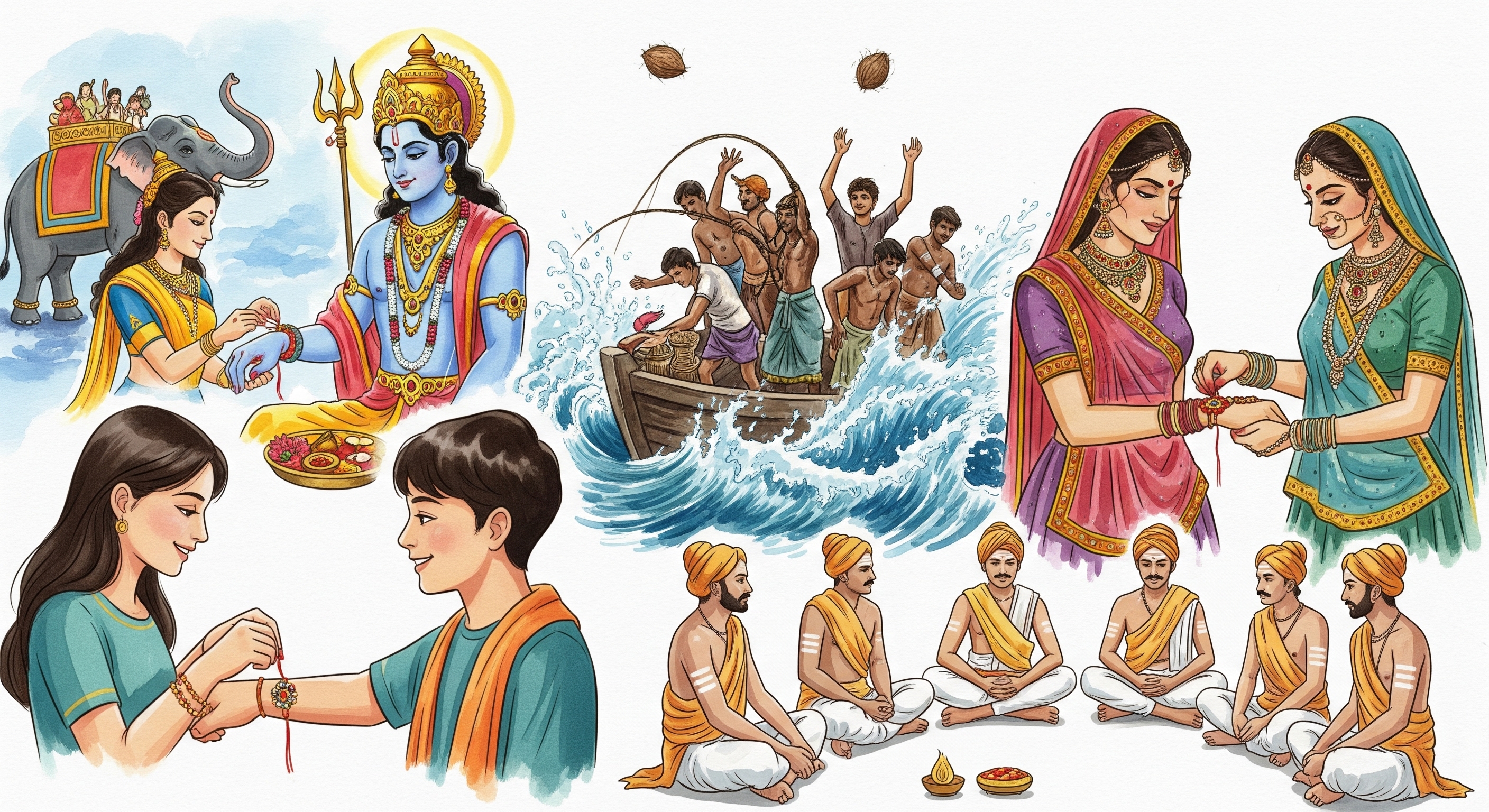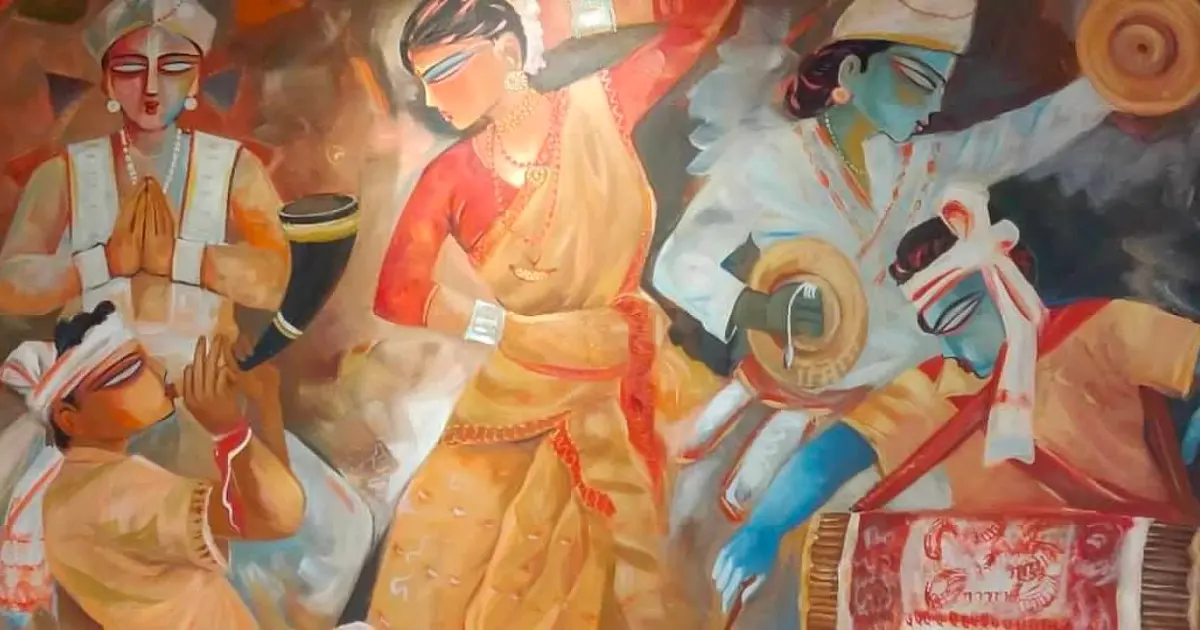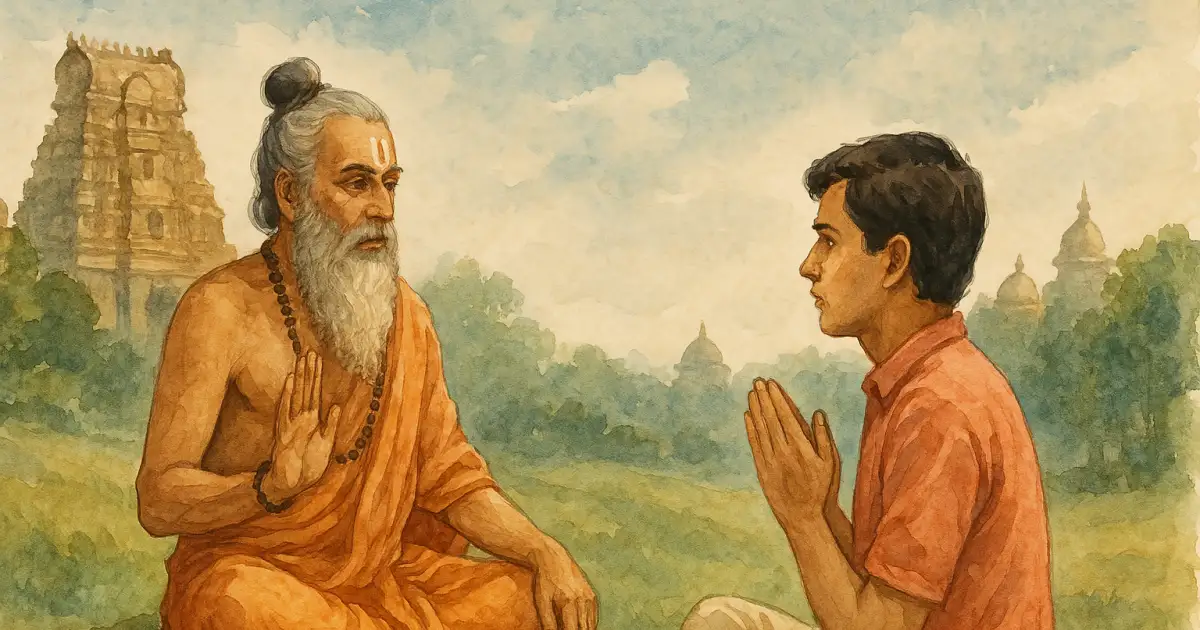Rakṣābandhana is a Hindu festival that occurs on the full moon day (purṇimā) of the Śrāvaṇa month (in Aug) as per the Hindu lunar calendar, celebrating the beautiful bond of love and protection between brothers and sisters.
Rakṣā
The word ‘rakṣā’ derives from the Saṃskṛta root/dhātu ‘rakṣa’ meaning ‘to protect, to guard, to preserve’.
Legend Behind Celebration
One of the central descriptions associated with Rakṣābandhana comes from the Bhaviṣya Purāṇa, which details a conversation between Yudhiṣṭhira and Lord Kṛṣṇa. Yudhiṣṭhira, the eldest of the Pāṇḍavas, inquires about the correct date and method for performing the Rakṣābandhana ceremony.
Lord Kṛṣṇa narrates that during a great battle between the gods and demons, Iṇḍra, the king of the gods, was on the verge of defeat. At this point, Iṇḍra’s wife, Indrāṇī or Śacī Devī, ties a sacred thread of protection around his wrist after blessing it with mantras.
Empowered by this protection, Iṇḍra was able to turn the tide of the battle and achieve victory over the demon King Bali. Śukrācārya, his preceptor, advises Bali not to battle with Iṇḍra for at least a year, till the effect of the sacred thread; which brings victory, happiness, health, and wealth, is in existence.
Lord Kṛṣṇa then advises the king to observe a ritual on the full moon day of Śrāvaṇa and describes the detailed process.
- The ritual begins with the participants waking up early, cleansing themselves, and offering food to the gods and ancestors.
- After completing the upākarma (a Vedic ritual), a rakṣā poṭlī (amulet) is prepared using sacred ingredients like rice, white mustard, dūrvā grass, and sandalwood, which are then placed in a copper vessel.
- A sacred square, or maṇḍala, is drawn on the ground with cow dung, and the participants, including the king and his ministers, sit around it.
- The rākhī is tied to his right wrist, while the priest chants a specific mantra, invoking the protection that King Bali will receive from this rākhī.
- The ritual concludes with the distribution of offerings and gifts to Brāhmaṇas, ensuring the happiness and prosperity of all participants throughout the year.
The Purāṇa recommends that this celebration of Rakṣābandhana should be observed by all four Varṇas.
The Mantra recited by priest is as follows:
येन बद्धो बली राजा दानवेन्द्रो महाबलः।
तेन त्वाम् अभिबध्नामि रक्षे मा चल मा चल॥The defense (raw thread given by Śacī Devī to Iṇḍra) that bound the great king of demons, Bali, I will bind you with the same thread; this defense bond will protect you forever.
Rituals
The most common celebrations of Rakṣābandhana start early in the morning. Sisters have the rākhīs ready (either purchased or made by themselves), to tie around their brothers’ wrists.
Materials advised to be used by practitioners (under śauca & sadācāra guidelines) for Rakṣābandhana are those that have the least/or no sparśa doṣa (impurities due to touch), such as wool, banana fibre, and silk.
The siblings sit together, and the sister performs the āratī (a fire ritual of worship), praying for her brother’s well-being and long life. She ties the rākhī on his wrist, and applies the tilak (a mark of auspiciousness) on his forehead. In return, the brother offers gifts, sweets, and promises to protect his sister in every manner possible throughout her life.
Upākarma ceremony
*On the day of Śrãvaṇa pūrṇimā, the Yajurveda and Ṛgveda Brāhmaṇas perform a very important and significant ritual of *Upākarma - the ceremonial changing of their janeū (sacred thread). This thread, also known as yajñopavita, is a promise they undertake to fulfill their duties towards the vaidika traditions. This renewal of vows on Rakṣābandhana aligns with the festival’s broader theme of protection and duty, as the janeū itself is considered a protective shield, safeguarding the wearer against negative influences and ensuring their spiritual growth.
McKim Marriott, an American anthropologist, during a field study in Kishan Garhi in the northern part of India observed two traditions of Śrāvaṇa pūrṇimā: Saluno, a local tradition where sisters place barley shoots on their brothers' heads, and also Rakṣābandhana (or charm tying), where Brāhmaṇa priests tie protective charms (rākhīs) on their patrons' wrists. The coexistence of the little tradition and the great tradition rituals, highlights the blending of local customs with the vaidika/paurāṇika practices.
Celebrations in Various Regions of India
Rakṣābandhana is celebrated with slight variations across different regions of India, reflecting Hindu dharma’s cultural diversity.
Rajasthan: In Rajasthan, the festival takes on a unique form with the tying of the Lumba Rakhi (sister-in-law/brother’s wife rākhī), a thread tied to the bangles of sisters-in-law, acknowledging the bond between sisters-in-law. It symbolizes the sister's prayer for the well-being of her brother as well as his spouse. It is prevalent among the Marwari community.
South India: In Tamil Nadu, śrāvaṇa pūrṇimā is observed as Avanī Aviṭṭam, the Upākarma ceremony. The Yajurveda and Ṛgveda Brahmins perform this. Brahmins gather and recite mantras, perform tarpaṇam (offering of water to ancestors), and replace their old yajñopavita with a new one.
Maharashtra: Nāralī (Coconut) Pūrṇimā is celebrated on this day, which is dedicated to Varuṇa (the sea god). It is celebrated by the Koli & other fishing communities who offer coconuts to the sea as a symbol of gratitude to the care and protection it provides them for their livelihood and they pray for its continuity. It also marks the beginning of the fishing season. It is performed at home and temples as well by families.
Protection - The Key Theme
Protection in Rakṣābandhana is a multi-layered concept, encompassing not only physical safety but also spiritual and emotional security. In the historical Ramtek mandir of Nagpur, it is an annual ritual for the purohita to tie rakṣā sūtras on the devotees on Rakṣābandhana day.
Rakṣābandhana is performed in many vratas;, Varaakṣmī vrata, Satyanārāyaṇa vrata, dīkṣā pradāna, pratiṣṭha vrata in temples - during all these functions, the yajmānā is tied a rakṣā sūtras by the purohit. All these are versions of Rakṣābandhana.
Comparison with Bhaiyā Dūj
Rakṣābandhana and Bhāī Dūj both highlight sibling bonds and their lifelong interdependence. Having said that, we must not overlook the fact that both are inherently unique in terms of their significance, tithi, as well as rituals. One is not to be substituted for the other.
Rakṣābandhana is a celebration of sibling love through the wishes of ‘protection’ for each other, which is symbolized by the consecrated thread. Bhāī Dūj, on the other hand, takes place around 2.5 months after Rakṣābandhana, where the brother visits the sister’s house, has to take his first meal there, blessings and gifts are exchanged, and through this ritual on this particular day, the sister is said to also get the opportunity to satisfy her maternal side pitṛs by feeding her brother, and they, in return, bless.
Bhāī Dūj is celebrated on the second day of śukla pakṣa of Kārtika month. Its story and rituals are detailed in The Bhaviṣya Purāna (Uttar Parva, Chapter 14, verses 18–27).
Lord Kṛṣṇa says: Yudhiṣṭhira! On the second day of śukla pakṣa of Kārtika month, Yamunā served food to her brother Yama in her house, and there was a big celebration in Yamaloka. The souls in Yamaloka were freed from their sins and, experiencing tremendous satisfaction, they danced around. Hence, the name of this day is Yamadvitīya. On this day, instead of eating at home, a brother should go to his sister's house and eat food prepared lovingly by her, which increases strength. In return, the sister should be satisfied with gold ornaments, clothes, and money etc. If one does not have a real sister, then one's father's brother's daughter, maternal uncle's daughter, aunts, or elder sister - these are also like sisters, one should eat from their hands. The man who eats food from his sister on Yamadvwitīya gets wealth, fame, life, religion, wealth, and unlimited happiness.
Conclusion
Rakṣābandhana is a festival that celebrates the timeless bond of love, protection, and mutual respect between siblings. However, its significance goes beyond the brother-sister relationship. Rooted in ancient scriptures and enriched by historical and cultural narratives, Rakṣābandhana is a powerful symbol of protective bonds that are not just confined to family but extend to the wider community.
References
- The Practical Sanskrit-English Dictionary
- https://archive.org/details/ldpd_7285627_000/page/900/mode/1up?view=theater
- https://archive.org/details/bhavishya-puran-gita-press-gorakhpur/page/n555/mode/2up?view=theater
- https://www.youtube.com/watch?v=NfVpQ9urRD4
- https://www.youtube.com/watch?v=Efd-1yj4DQI
- https://www.amarujala.com/lifestyle/rakhi-celebrations-lumba-rakhi-for-sister-in-law-at-rakshabandhan-festival
- https://archive.org/details/BhavishyaPuranPart1/Bhavishya%20Puran%20Part%203%20%20/page
- https://www.thehindu.com/society/faith/importance-of-avani-avittam/article67243831.ece
- https://www.hindustantimes.com/lifestyle/festivals/what-is-narali-purnima-the-festival-that-coincides-with-raksha-bandhan-know-date-rituals-significance-101693310203929.html
- https://www.hamropatro.com/posts/articles-events/articles-events-english-janai-purnima
- https://youtu.be/zNsqaZtZnqk?si=XOF695n-YuR2FNJW





